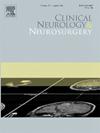超进化分流器的有效性和安全性:系统回顾和荟萃分析
IF 1.8
4区 医学
Q3 CLINICAL NEUROLOGY
引用次数: 0
摘要
目的为超进化分流器(se - fd)治疗颅内动脉瘤的安全性和有效性提供累积证据。方法检索spubmed、Scopus、Embase和Web of Science至2024年5月。主要疗效终点为完全闭塞率,安全性终点为各种并发症发生率和死亡率。使用随机效应模型将数据汇总并以95% %置信区间(ci)报告。进行meta回归分析以评估混杂因素对研究终点的潜在影响。结果共纳入690例患者,757个动脉瘤。所有研究均存在中等偏倚风险。中位随访243天,完全闭塞率为67.1 %(95 %CI: 57.3-75.5 %,I2=72 %),破裂和未破裂动脉瘤之间无差异(p = 0.97)。支架狭窄是最常见的并发症,在306天的中位随访中发生18.2% %(95 %CI: 10.3-30.1 %,I2=71 %)的动脉瘤。血栓栓塞性并发症发生率为6.6 %(95 %CI: 3.8 ~ 11 %,I2=50 %),其中缺血性脑卒中发生率为1.9 %(95 %CI: 1.1 ~ 3.4 %,I2=0 %)。器械相关死亡率为0.5 %(95 %CI: 0.2-1.5 %,I2=0 %)。meta回归显示动脉瘤直径与完全闭塞率显著相关(系数:- 0.11,p <; 0.001)。结论se - fd是治疗颅内动脉瘤的有效方法,与其他装置相比疗效适中,并发症发生率可接受。较大的动脉瘤预示着较低的闭塞率。由于缺乏对照试验,需要进一步研究se - fd在临床实践中的有效性和安全性。本文章由计算机程序翻译,如有差异,请以英文原文为准。
Efficacy and safety of surpass evolve flow diverters: A systematic review and meta-analysis
Objective
To provide cumulative evidence on the safety and efficacy of the Surpass Evolve Flow Diverters (SE-FDs) in treating intracranial aneurysms.
Methods
PubMed, Scopus, Embase, and Web of Science were searched until May, 2024. The primary efficacy endpoint was complete occlusion rate, and the safety endpoints included rate of different complications and mortality. Data is pooled and reported with 95 % confidence intervals (CIs) using random-effect models. A meta-regression analysis was performed to assess the potential effects of confounding factors on study endpoints.
Results
Eleven studies with 690 patients and 757 aneurysms were included. There was moderate risk of bias in all studies. With a median follow-up of 243 days, the complete occlusion rate was 67.1 % (95 %CI: 57.3–75.5 %, I2=72 %), with no difference between ruptured and unruptured aneurysms (p = 0.97). Stent stenosis was the most frequent complication which occurred in 18.2 % (95 %CI: 10.3–30.1 %, I2=71 %) of aneurysms at a median follow-up of 306 days. The rate of thromboembolic complications was 6.6 % (95 %CI: 3.8–11 %, I2=50 %), including ischemic stroke in 1.9 % (95 %CI: 1.1–3.4 %, I2=0 %) of patients. Device-related mortality rate was 0.5 % (95 %CI: 0.2–1.5 %, I2=0 %). Meta-regression showed that diameter of aneurysm was significantly associated with complete occlusion rate (coefficient: - 0.11, p < 0.001).
Conclusions
SE-FD is effective for treating intracranial aneurysms, with moderate efficacy compared to other devices and an acceptable rate of complications. Larger aneurysm size predicts lower occlusion rates. The lack of controlled trials warrants further research to explore the efficacy and safety of SE-FDs in clinical practice.
求助全文
通过发布文献求助,成功后即可免费获取论文全文。
去求助
来源期刊

Clinical Neurology and Neurosurgery
医学-临床神经学
CiteScore
3.70
自引率
5.30%
发文量
358
审稿时长
46 days
期刊介绍:
Clinical Neurology and Neurosurgery is devoted to publishing papers and reports on the clinical aspects of neurology and neurosurgery. It is an international forum for papers of high scientific standard that are of interest to Neurologists and Neurosurgeons world-wide.
 求助内容:
求助内容: 应助结果提醒方式:
应助结果提醒方式:


